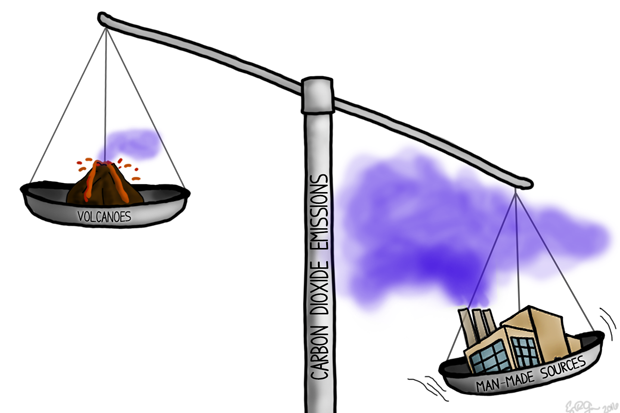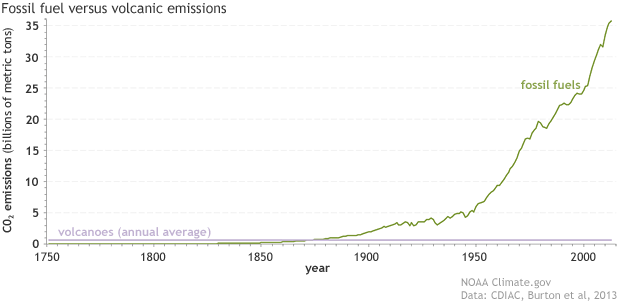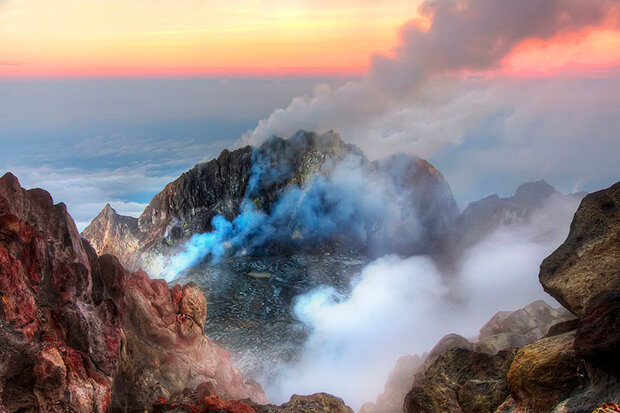[ Envirowatchers ] [ Main Menu ]
18876

From: Eve, [DNS_Address]
Subject: Which emits more carbon dioxide: volcanoes or human activities?
|
Excerpt: BY MICHON SCOTT AND REBECCA LINDSEY REVIEWED BY TERRENCE GERLACH PUBLISHED JUNE 15, 2016 Image Caption: On the scale of carbon dioxide emissions, human sources far outweigh volcanoes. NOAA Climate.gov cartoon by Emily Greenhalgh. Human activities emit 60 or more times the amount of carbon dioxide released by volcanoes each year. Large, violent eruptions may match the rate of human emissions for the few hours that they last, but they are too rare and fleeting to rival humanity’s annual emissions. In fact, several individual U.S. states emit more carbon dioxide in a year than all the volcanoes on the planet combined do. Human activities Human activities—mostly burning of coal and other fossil fuels, but also cement production, deforestation and other landscape changes—emitted roughly 40 billion metric tons of carbon dioxide in 2015. Since the start of the Industrial Revolution, more than 2,000 billion metric tons of carbon dioxide have been added to the atmosphere by human activities according to the Global Carbon Project.  Since the start of the Industrial Revolution, human Since the start of the Industrial Revolution, human emissions of carbon dioxide from fossil fuels and cement production (green line) have risen to more than 35 billion metric tons per year, while volcanoes (purple line) produce less than 1 billion metric tons annually. NOAA Climate.gov graph, based on data from the Carbon Dioxide Information Analysis Center (CDIAC) at the DOE's Oak Ridge National Laboratory and Burton et al., 2013. Volcanoes Volcanoes emit carbon dioxide in two ways: during eruptions and through underground magma. Carbon dioxide from underground magma is released through vents, porous rocks and soils, and water that feeds volcanic lakes and hot springs. Estimates of global carbon dioxide emissions from volcanoes have to take both erupted and non-erupted sources into account.  Much of the carbon dioxide released by volcanoes is emitted by degassing of subterranean magma when the volcano is not erupting. In this photo, volcanic gases and steam rise from Mount Merapi, Indonesia, on May 20, 2012. In a 2011 peer-reviewed paper, U.S. Geologic Survey scientist Terry Gerlach summarized five previous estimates of global volcanic carbon dioxide emission rates that had been published between 1991 and 1998. Those estimates incorporated studies reaching back to the 1970s, and they were based on a wide variety of measurements, such as direct sampling and satellite remote sensing. The global estimates fell within a range of about 0.3 ± 0.15 billion metric tons of carbon dioxide per year, implying that human carbon dioxide emissions were more than 90 times greater than global volcanic carbon dioxide emissions. .....article continues at link provided..... |
Responses:
[18887]
18887
From: eaamon, [DNS_Address]
Subject: Re: Which emits more carbon dioxide: volcanoes or human activities?
| I might also add humans not just their activity. |
Responses:
None
[ Envirowatchers ] [ Main Menu ]